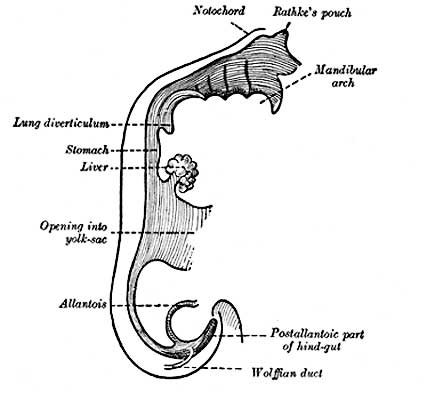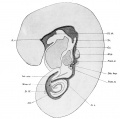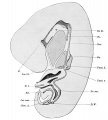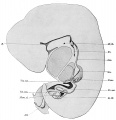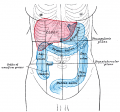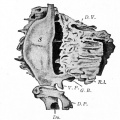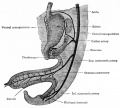Gastrointestinal Tract - Stomach Development
| Embryology - 27 Apr 2024 |
|---|
| Google Translate - select your language from the list shown below (this will open a new external page) |
|
العربية | català | 中文 | 中國傳統的 | français | Deutsche | עִברִית | हिंदी | bahasa Indonesia | italiano | 日本語 | 한국어 | မြန်မာ | Pilipino | Polskie | português | ਪੰਜਾਬੀ ਦੇ | Română | русский | Español | Swahili | Svensk | ไทย | Türkçe | اردو | ייִדיש | Tiếng Việt These external translations are automated and may not be accurate. (More? About Translations) |

Introduction
This section of notes gives an overview of how the stomach and duodenum develops. The GIT is best imagined as a simple tube, the upper part being the foregut diverticulum, which is further divided into oesophagus and stomach.
During week 4 at the level where the stomach will form the tube begins to dilate, forming an enlarged lumen. The dorsal border grows more rapidly than ventral, which establishes the greater curvature of the stomach.[1] A second rotation (of 90 degrees) occurs on the longitudinal axis establishing the adult orientation of the stomach.
Some Recent Findings
|
| More recent papers |
|---|
|
This table allows an automated computer search of the external PubMed database using the listed "Search term" text link.
More? References | Discussion Page | Journal Searches | 2019 References | 2020 References Search term: Stomach Embryology | Stomach Development |
Components of Stomach Formation
primitive endoderm
- foregut diverticulum (pocket)
- pharyngeal region of foregut
- laryngo-tracheal groove (see respiratory tract)
- oesophageal region of foregut
- oesophagus
- stomach
- glandular/proventricular/pyloric stenosis
- fundus/pyloric antrum
- pyloric sphincter
- fundus/pyloric antrum
- dorsal mesogastrium
- lieno-renal ligament
- splenic primordium
- spleen
- gastro-splenic ligament
- duodenum (rostral half)
- splenic primordium
- lieno-renal ligament
- glandular/proventricular/pyloric stenosis
- stomach
- oesophagus
- pharyngeal region of foregut
- foregut-midgut junction
- midgut region
- hindgut diverticulum (pocket)
Modified from [4]
Movies
|
|
|
|
|
|
Stage 13
The images below link to larger cross-sections of the mid-embryonic period (end week 4) stage 13 embryo starting just above the level of the stomach and then in sequence through the stomach to the level of the duodenum.
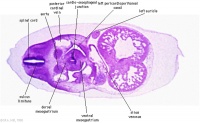
|
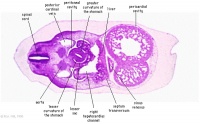
|
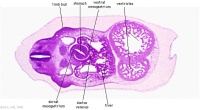
|
| D2 Cardio-oesophageal junction | D3 Stomach body | D4 Stomach body |
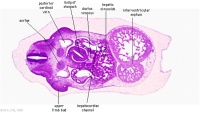
|
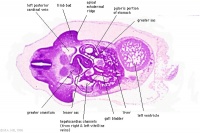
|
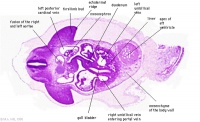
|
| D5 Stomach body | D6 Pyloric junction | D7 Duodenum |
|
This is an animation based on a reconstruction of the above embryo entire stage 13 gastrointestinal tract. |
Stage 22
The images below link to larger cross-sections of the end of the embryonic period (week 8) stage 22 embryo starting just above the level of the stomach and then in sequence through the stomach to the level of the duodenum. Note how the stomach is "embedded" within the large developing liver.
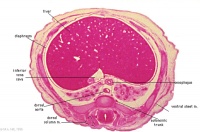
|
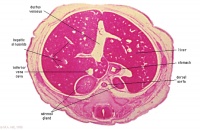
|
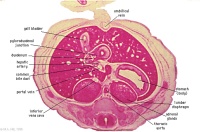
|
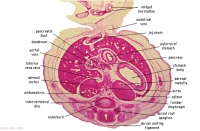
|
| E5 Oesophagus | E6 Cardio-oesophageal junction | E7 Stomach body Pyloric junction | F1 Stomach body Pylorus |
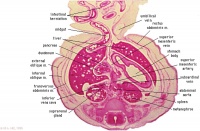
|
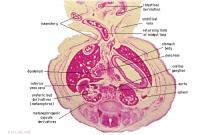
|
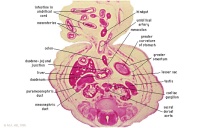
|

|
| F2 Stomach body | F3 Stomach body Duodenum | F4 Duodenal-Jejunal junction | F5 Duodenum Jejunum |
|
This is an animation based on a reconstruction of the above embryo entire stage 22 gastrointestinal tract. |
Stomach Mesentery
In the second trimester, the ventral and dorsal mesenteries associated with the stomach are still anatomically different from the newborn. The figure shows a lateral view of this process comparing the early second trimester arrangement with the newborn structure.
Ventral Mesogastrium
Attached to the superior end of the stomach will form the lesser omentum. This structure will connect the lesser curvature of the stomach to the liver as a ligamentous structure.
Dorsal Mesogastrium
Attached to the inferior end of the stomach initially as an extended fold, this later fuses as a single "apron-like" structure, the greater omentum. Fusion will also incorporate the transverse colon part of the large intestine. This will also contribute the gastrosplenic ligament (gastrolienal ligament).
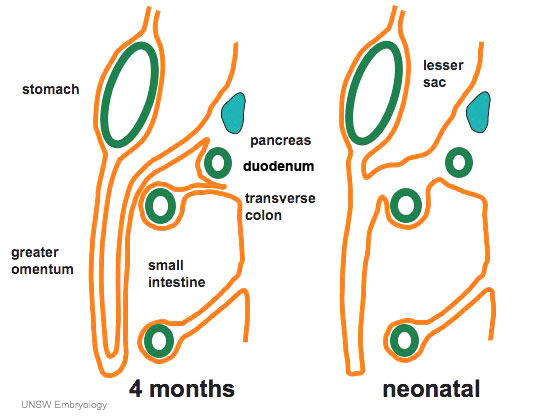
|
The greater omentum hangs like an apron over the small intestine and transverse colon. It begins attacted to the inferior end of the stomach as a fold of the dorsal mesogastrium which later fuses to form the structure we recognise anatomically. The figure below shows a lateral view of this process comparing the early second trimester arrangement with the newborn structure. |
Duodenum/Pancreas Rotation
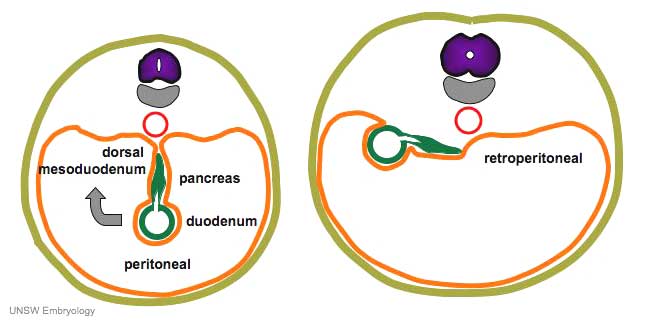
|
After the stomach the initial portion of the gastrointestinal tract tube is the duodenum which initially lies in the midline within the peritoneal cavity.
This region, along with the attached pancreas, undergoes rotation to become a retroperitoneal structure. This diagram shows the rotation with spinal cord at the top, vertebral body then dorsal aorta then pertioneal wall and cavity. |
Glands
The data below comes from a historic study by Johnson (1910)[5]
- Early - A few vacuoles, similar to those of the oesophagus, are found in corresponding stages in the stomach.
- 16 mm - the smooth epithelium begins to show a number of pit-like depressions, the first appearances of the gastric pits. These rapidly increase in number and many become elongated to form grooves. At first the basal surface of the epithelium shows no irregularities due to the gastric pits. Then appear slight swellings into the mesenchyma. Still later depressions or furrows, alternating with the gastric pits, extend inward into the epithelium from the mesenchymal surface. This brings about a readjustment of the cells, and causes the heretofore 2 to 3 layered epithelium to become single layered.
- The groove-like pits anastomose with one another to form a network. This network marks out irregular areas of the surface epithelium, which have been described as villi.
- Growth of the mucous membrane is accompanied by an increase in the number of pits and by an increase in their size. The additional pits develop in between those already formed.
- 120 mm - Glands first seen bud out from the bottoms of the pits. These rapidly increase in number and give off branches. Parietal cells are first distinct at 120 mm
- Large longitudinal folds of the mucous membrane occur in the stomach, but are variable in position, number, and size. Their occurrence is probably due to the contraction of the muscularis.
Stomach Hormonal Development
The gastrointestinal tract has its own complex entero-endocrine system (enterohormones) that regulates many regional tract functions.
Cells within the stomach express a range of peptide hormones known to regulate a range of gastric functions including secretion of digestive enzymes, mucous and the movement of the luminal contents. The list below shows the earliest detectible presence of specific hormone-containing cells in regions of the developing human stomach.
Hormonal Timecourse
8 weeks - Gastrin containing cells in stomach antrum. Somatostatin cells in both the antrum and the fundus.
10 weeks - Glucagon containing cells in stomach fundus.
11 weeks - Serotonin containing cells in both the antrum and the fundus.
Expression data based upon[6]
Other Gut Peptides
- Cholecystokinin (CCK), pancreatic polypeptide, peptide YY, glucagon-like peptide-1 (GLP-1), oxyntomodulin (increase satiety and decrease food intake) and ghrelin
Mouse
The images below show differential gene expression of some selected markers during development (E10.5 and E13.5) of the mouse gastrointestinal tract.[7]
- Links: Mouse Development | Full original figure | E10.5 | E13.5
References
- ↑ 1.0 1.1 Davis A, Amin NM, Johnson C, Bagley K, Ghashghaei HT & Nascone-Yoder N. (2017). Stomach curvature is generated by left-right asymmetric gut morphogenesis. Development , 144, 1477-1483. PMID: 28242610 DOI.
- ↑ Johannesson M, Ståhlberg A, Ameri J, Sand FW, Norrman K & Semb H. (2009). FGF4 and retinoic acid direct differentiation of hESCs into PDX1-expressing foregut endoderm in a time- and concentration-dependent manner. PLoS ONE , 4, e4794. PMID: 19277121 DOI.
- ↑ Shin M, Noji S, Neubüser A & Yasugi S. (2006). FGF10 is required for cell proliferation and gland formation in the stomach epithelium of the chicken embryo. Dev. Biol. , 294, 11-23. PMID: 16616737 DOI.
- ↑ Kaufman & Bard, The Anatomical Basis of Mouse Development, 1999 Academic Press
- ↑ Johnson FP. The development of the mucous membrane of the oesophagus, stomach and small intestine in the human embryo. (1910) Amer. J Anat., 10: 521-559.
- ↑ Stein BA, Buchan AM, Morris J & Polak JM. (1983). The ontogeny of regulatory peptide-containing cells in the human fetal stomach: an immunocytochemical study. J. Histochem. Cytochem. , 31, 1117-25. PMID: 6136542 DOI.
- ↑ Matsuyama M, Aizawa S & Shimono A. (2009). Sfrp controls apicobasal polarity and oriented cell division in developing gut epithelium. PLoS Genet. , 5, e1000427. PMID: 19300477 DOI.
Reviews
McCracken KW & Wells JM. (2017). Mechanisms of embryonic stomach development. Semin. Cell Dev. Biol. , 66, 36-42. PMID: 28238948 DOI.
Kim TH & Shivdasani RA. (2016). Stomach development, stem cells and disease. Development , 143, 554-65. PMID: 26884394 DOI.
Zorn AM & Wells JM. (2009). Vertebrate endoderm development and organ formation. Annu. Rev. Cell Dev. Biol. , 25, 221-51. PMID: 19575677 DOI.
Fukuda K & Yasugi S. (2005). The molecular mechanisms of stomach development in vertebrates. Dev. Growth Differ. , 47, 375-82. PMID: 16109035 DOI.
Yasugi S. (1994). Regulation of pepsinogen gene expression in epithelial cells of vertebrate stomach during development. Int. J. Dev. Biol. , 38, 273-9. PMID: 7526882
Johnson LR. (1985). Functional development of the stomach. Annu. Rev. Physiol. , 47, 199-215. PMID: 3922287 DOI.
Deren JS. (1971). Development of structure and function in the fetal and newborn stomach. Am. J. Clin. Nutr. , 24, 144-59. PMID: 4923462
Articles
Shin M, Noji S, Neubüser A & Yasugi S. (2006). FGF10 is required for cell proliferation and gland formation in the stomach epithelium of the chicken embryo. Dev. Biol. , 294, 11-23. PMID: 16616737 DOI.
Yasugi S. (2000). Epithelial cell differentiation during stomach development. Hum. Cell , 13, 177-84. PMID: 11329933
Search Pubmed
Search Bookshelf: Stomach Development
Search Pubmed Now: Stomach Development
Historic References
Template:Ref-GrosserLewisMcmurrich1912
Bardeen CR. The critical period in the development of the intestines. (1914) Amer. J Anat. 16: 427 – 445.
Images
Historic Images
| Historic Disclaimer - information about historic embryology pages |
|---|
| Pages where the terms "Historic" (textbooks, papers, people, recommendations) appear on this site, and sections within pages where this disclaimer appears, indicate that the content and scientific understanding are specific to the time of publication. This means that while some scientific descriptions are still accurate, the terminology and interpretation of the developmental mechanisms reflect the understanding at the time of original publication and those of the preceding periods, these terms, interpretations and recommendations may not reflect our current scientific understanding. (More? Embryology History | Historic Embryology Papers) |
Glossary Links
- Glossary: A | B | C | D | E | F | G | H | I | J | K | L | M | N | O | P | Q | R | S | T | U | V | W | X | Y | Z | Numbers | Symbols | Term Link
Cite this page: Hill, M.A. (2024, April 27) Embryology Gastrointestinal Tract - Stomach Development. Retrieved from https://embryology.med.unsw.edu.au/embryology/index.php/Gastrointestinal_Tract_-_Stomach_Development
- © Dr Mark Hill 2024, UNSW Embryology ISBN: 978 0 7334 2609 4 - UNSW CRICOS Provider Code No. 00098G
